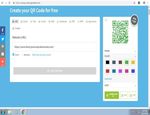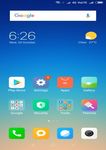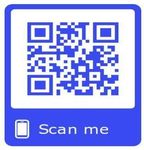Integration of AIDC Technology in Mobile via QR Code for Enhancing the Library Services: A Case Study of Don Bosco College Central Library ...
←
→
Page content transcription
If your browser does not render page correctly, please read the page content below
Indian Journal of Information Sources and Services
ISSN: 2231-6094 Vol. 9 No. 2, 2019, pp. 44-48
© The Research Publication, www.trp.org.in
Integration of AIDC Technology in Mobile via QR Code for
Enhancing the Library Services: A Case Study of Don Bosco
College Central Library, Arunachal Pradesh
Sur Chandra Singha1 and Manoj Kumar Verma2
1
Librarian, Don Bosco College, Itanagar, Arunachal Pradesh, India
2
Assistant Professor, Department of Library and Information Science, Mizoram University, Aizawl, Mizoram, India
E-Mail: surchandrasngh162@gmail.com, manojdlis@mzu.edu.in
Abstract - In this digital era, QR Code is becoming one of the 1890: No.50 SR/ITA/4034). The College is named after St.
most popular tools and it great help to website towards John Bosco (1815 – 1888) popularly known as Don Bosco –
strengthening the relationship and promoting enhanced to Father and Friend of Youth. He was a Catholic priest and a
existing library website. Q R Code is a state of art AIDC prominent educationist engaged in the welfare of
technology that is gaining popularity with Library fraternity in
youngsters. (Source: https://dbcitanagar.com/)
India. It is one such technology which can offer to the user
demand of providing access to e-resources through mobile.
These advanced technologies offer access very convenient, II. AUTOMATIC IDENTIFICATION AND DATA
instantaneous information, across boundaries of subject and CAPTURE (AIDC)
particular area. Don Bosco College Central Library is set an
example in experimenting with adopting new technology ―Automatic Identification and Data Capture (AIDC) refers
developments; where it is computerization and automation or to the methods of automatically identifying objects,
adopting other ICT to improve facilities their services. The collecting data about them, and entering that data directly
rapid developments in ICT have given a solid foundation for into computer systems (i.e., without human involvement)‖.
revolutionary changes in the information handling capabilities
(Source: https://en.wikipedia.org/wiki/Automatic_identifica
of information dissemination. Don Bosco College Central
Library may well reach out to the remote users who were tion_and_data_capture)
considered unlikely to connect because of absence of a
medium. Users are becoming increasingly web savvy reliant on A. Advantages of AIDC Technology in Library
advance technologies for sharing, accessing and determining
their information. Keeping in mind, researcher integrated AIDC makes it easy to identify and find out the exact
AIDC in Mobile viaQR Code Technology in Don Bosco College books search by user and helps to stock verification and
Central Library Website for enhancing library services. self-rectification.
Keywords: QR Code, AIDC, RFID, Bar Code, OCR, Digital
Library
1. AIDC enables real-time monitoring of the number of
books issued out & returned transaction in a day.
I. INTRODUCTION
2. It eliminates errors associated with identification and
data collected by AIDC harvests information about the
AIDC technology can be used in different day to day library
location of Books Shelves as well as open space
activities like self-check in, check out, self-rectification,
available for storage.
making library card, self-management, anti-theft detection,
3. It reduces data entry costs and save valuable time of
CAS, SDI, and stock verification etc. Automatic
reader to find out the book as per their requirement
identification offers quickly, accurate and easy for data
books.
collection approaches. Once data is captured it can be stored
or analyzed by a computer or other device. AIDC
B. AIDC Technologies
techniques in usual do not require human involvement in
order to capture data, these methods comprise technologies
There are several types of AIDC technology using in
namely biometrics, QR Code, barcodes, OCR, OMR and
library.
RFID etc. This information can be used for control
functions relevant to the specific items as well as for
1. Bar Code Technology: Barcode technology is an
automatically identification item’s conditions and decision
appropriate technique in library to minimize the time
making if it’s needed.
taken at the circulation counter in library. Barcodes
used for issue/return of books libraries and have to
Don Bosco College, Itanagar (Jollang) is an educational
resort to stock verification, at intervals. If the delivery
institution of the Catholic Church, belonging to and
for multiple barcodes or multidimensional barcoding is
managed by the Salesians of Don Bosco Educational
integrated to handle call number information also,
Society (registered under the Societies Registration Act of
IJISS Vol.9 No.2 April-June 2019 44Integration of AIDC Technology in Mobile via QR Code for Enhancing the Library Services:
A Case Study of Don Bosco College Central Library, Arunachal Pradesh
wrong shelving of library books can be auto detected ―generate‖ button. It is instantly generated and can be
which would support the staff to rectify the same. saved, copied or embedded.
2. Biometric Identification – Fingerprint, Retinal Scan or III. DON BOSCO COLLEGE CENTRAL LIBRARY
Voice: Biometrics technology in libraries regularly WEBSITE
comprises of fingerprint identification software and
hardware. A fingerprint-based door locks & hand Don Bosco College Central Library provide a unique
geometry verification system. Biometric system can be platform for promoting various library services like new
used successfully such as circulation section, gate arrival journal, new arrival books, download corner,
checking, internet searching, stack entry record, using feedback corner, faculty corner, student career corner,
digital library, employee time and staff attendance etc. virtual learning corner, civil service preparation, free online
With the help of Biometrics technology, it can easily be plagiarism checker, free online citation and many more at
introduced in the library full proof security cum one place. Students are the future of our nation and
automated library and user authentication system in researcher believes that this website will help and bring
library successfully. It can acts as a helpful them to reach their goal of their life with distinction and
management tool for the library professionals if it is maintain the integrity of the career by accomplishment of
usein library patron records very quickly, accurately their knowledge though this virtual forum.
and systematically in scientific way.
IV. SCOPE AND COVERAGE OF THE STUDY
3. Magnetic Strips & MICRs: MICR stands for Magnetic
Ink Character Recognition. These applications used in The scope of the present study is limited to the Don Bosco
mainly in banking sector but very limited application in College Central Library website QR codes which are used
libraries. MICR isfrequently used in user ID cards. for dissemination of information to their users.
Ithelps the security systems at the entrance to allow
only the authorized users in and get the material issued V. OBJECTIVES OF THE STUDY
to them.
The objectives of present study are:
4. Optical Character Recognition (OCR): Optical 1. To create awareness about the QR code.
character recognition or optical character reader, often 2. To recognize the installation process of QR code.
abbreviated as OCR. OCR used to convert the existing 3. To know the process of QR codes generation.
resources in documentary form (printed) to digital form 4. To analyze the services given by Don Bosco College
such as PDF. The books, magazines and periodicals etc. through QR code.
are scanned using some optical reader and saved in
digital format either in computer itself or onto some VI. METHODOLOGY
secondary storage device like floppy or CD. OCR is
very useful technology to digitize documents and books Researcher adopted qualitative research methods for the
in digital libraries. purpose of case study. The present study examine applies,
issues and implementation of the same technologies in a
5. Radio Frequency Identification (RFID): RFID stands particular website. The present paper discussed with an
for Radio Frequency Identification. It is used in introduction, area coverage, objectives, its advantages and
libraries for book identification, for self-in/self- disadvantages and generating Q R Code, promoting services
checkout, antitheft control, inventory control, and in website and library.
sorting and conveying of library books and AV
materials. VII. LITERATURE REVIEW
6. Real Time Locating Systems. (RTLS): RTLSs used Mishra (2017) discussed & examined that a library user can
automatically recognize, track, and visualize objects easily get information regarding library collection, e-
that are usually within indoor or confined environments resource, library web site, Web-OPAC in a user-friendly
mainly using RF identification (RFID). environment. Number of libraries adopted this technological
code to spread information worldwide. Library’s
7. QR code Technology: QR code stands for Quick information professional using this technology without any
response code. It is a matrix barcode readable by smart dependency. Many QR code generator also available to
phones and android phones with cameras. It is generate QR Code for library collection, architecture design
sometimes mentioned to as 2d barcodes, 2d codes, or of library building, e-books, visiting cards, bookmarks, user
mobile codes. It allows four different content types, manual or blog.
text, a URL, SMS or phone number and a choice of
four sizes— large, or extra-large, medium and small. Pathak (2017) revealed that QR codes in providing Current
Generating a code is as simple as choosing a content Awareness Service/Ready Reference Service like library
type, adding URL or other data, and clicking the website, Web OPAC, list of Ph.D. theses, e-Resources,
45 IJISS Vol.9 No.2 April-June 2019Sur Chandra Singha and Manoj Kumar Verma
book requisition / library membership form, digital payment 4. It increase the users satisfaction and useful to achieve
for library book overdue, list of CD-ROMs, library guide, the fulfill library goals of Ranganathan fourth law i.e.
library manual, institutional digital repository (IDR), open save the time of reader;
access resources, union catalogue of e-resources, new 5. Anybody can generate the QR code using free software;
arrivals, list of print magazines, discovery tool service & 6. It is used in promoting the library services like DDS,
List of News Papers etc. used in central library, IISER SDI and quick reference services etc.
Bhopal. 7. It helps human errorless when a person particularly
search the web.
Rahaman (2016) observed that Central Library, NIT,
Rourkela started using QR code for many purposes like, in B. Disadvantage of QR Code
the banners of the workshop, training, seminar, conference,
induction programmes; advertisement; notices; websites; 1. It requires an internet connection along with smart
URLs etc. not only in the webs but also in the printed forms phone, android phone, Desktop (with camera) and QR
too. code scanning software;
2. Still users are not fully awareness. Awareness among
VIII. QR CODE users toward QR code technology is also very essential
to fulfill effective website & library services;
QR code is used in a variety of ways by different 3. Human errors occur sometimes at the time of coding;
organizations for their personal purposes like promoting and 4. Q R Codes are not working properly sometimes due to
marketing the products. Library uses it as a medium to the compatibility of the decoder.
communicate the users to their documents/information that
they want. The 21st century libraries are fully automated C. Requirements for Scanning QR Code
and they know the users’ demands. They always try to
provide world class services to their users beyond physical 1. Internet connection (either through the phone’s data
boundaries. There are many libraries abroad that have plan or over a site generated wireless network);
implemented QR code. With the advent of ICT and 2. Smart phone, Android, Desktop (with Camera) with
awareness of technology among people, QR codes are being QR Code reader/scanner ;
used everywhere. So QR codes can be used in library books, 3. Handy scanner/handy terminals/fixed scanner;
journals, CD-ROMs, ticketing, entertainment and transport 4. Printer;
ticketing, VCard information, commercial tracking,
product/loyalty marketing and in-store product labeling. So D. Process of Generating QR Codes
we can say that QR code can be used in a variety of ways as It is very simple process of generating QR Codes. There are
per need. (Parabhoi & Dhar 2017). a number of free QR code generators easily available on the
web. There are two types of QR Code (One is static and
second is dynamic). Static QR codes cannot be edited at
any time after generating the code which is one type job but
dynamic QR codes which is editable even after printing as
per our need.
First step, one need to select QR code generator website
(ex.: http://www.qr-code-generator.com)
Fig. 1 Different QR codes used in Don Bosco Collage Library
A. Advantage of QR Code
1. It is always available free of cost in web;
2. It can hold much more information than a regular Fig. 2 Selection of QR code generator website
barcode and can be used anywhere at any time;
3. QR Code is user friendly technology and users do not Second step, need to select one of the desire & require
need specific expertise for using this technology, only navigation tools (like URL, VCard, Text, Email, SMS,
required smart phones like Android phone, iPhone, etc. Facebook, PDF, MP3, App stores & images). Here,
with QR code scanner;
IJISS Vol.9 No.2 April-June 2019 46Integration of AIDC Technology in Mobile via QR Code for Enhancing the Library Services:
A Case Study of Don Bosco College Central Library, Arunachal Pradesh
researcher choose own URL of Library Science
Professionals website for demonstration purpose.
Fig. 6 Final Step to generate QR code
E. Manual of Using QR Code in Don Bosco College Library
Website
Fig. 3 Select of desire & require navigation tools
1. First step, go to mobile android (Google Play Store).
Third step, uploading the desired document (ex. URL) and
click at next or if require additional feature require then can
do color frame. Otherwise, normally do black and white
color or click at done/create QR code.
Fig.7 Step-1
Fig. 4 uploading the desired document 2. Second step, search & download (free Q R scanner
app).
Fourth step, if require any additional feature then can do
color logo. Otherwise, normally do black and white color or
click at done/create QR code.
Fig. 5 Steps to add additional features
Fifth step, now file is ready to download and save.
Fig.8 Step-2
47 IJISS Vol.9 No.2 April-June 2019Sur Chandra Singha and Manoj Kumar Verma
3. Third step, after completing the download (install the Q in such way that users will find not only satisfactory, but
R Code Scanner App) successfully. tailored to their needs. The Q R Code revolution
compromise both challenges and prospects for researcher.
Researcher efforts will support and attempt to entice new
users, expand the usage of existing users, and highlight
specific library products also.
REFERENCES
[1] Ashford, R. (2010). QR codes and academic libraries: Reaching
mobile users. College & Research Libraries News, 71(10), 526-530.
doi:10.5860/crln.71.10.8454
[2] Barker, K. R., Attridge, E., Bennett, J., Hiserman, T., Horne, A. S.,
Moody, D., & Vaughn, P. (2012). The implementation of embedded
quick response codes into library resources to improve service
delivery. Journal of the Medical Library Association: JMLA, 100(1),
68-71. doi:10.3163/1536-5050.100.1.013
[3] Briseno, M. V., Hirata, F. I., Sanchez-Lopez, J. D., Garcia,, E. J.,
Cota, C. N., & Hipolito, J. N. (n.d.). Using RFID/NFC and QR-Code
in Mobile Phones to Link the ... Retrieved March 30, 2019, from
http://cdn.intechopen.com/pdfs/31056/InTech-Using_rfid_nfc_and_
qr_code_inmobile_phones_to_link_the_physical_and_the_digital_wo
rld.pdf
[4] Faizuddin, S. M., Azeeza, S. E., & Khaparde, V. S. (2015). QR code
Fig.9 Step-3 & its use in libraries. Knowledge Librarian, 2(1), 193-205. Retrieved
March 28, 2019, from http://www.klibjlis.com/2.1.10.pdf
[5] Hicks, A., & Sinkinson, C. (2011). Situated Questions and Answers
4. Forth step, scan the following Quick Response Code Responding to Library Users with QR Codes. Reference & User
(QR Code) & open this website in your smart phones. Services, 51(1), 60-69. Retrieved March 28, 2019, from
(Ex. https://www.librarydbc.com/) https://journals.ala.org/index.php/rusq/article/viewFile/3582/3897.
[6] Mishra, A. S., Umre, S. K., & Gupta, P. K. (2017). QR Code In
Library Practice Some Examples. International Journal of
Engineering Sciences & Research Technology, 6(2), 319-326.
doi:10.5281/zenodo.290267
[7] Parabhoi, L., Bhattacharjya, N., & Dhar, R. (2017). Use of QR Code
in Library. Retrieved March 29, 2019, from https://www.academia.
edu/33800175/Use_of_QR_Code_in_Library
[8] Pathak, S. K. (2017). Application of QR Code Technology in
providing Library and ...Retrieved March 29, 2019, from http://events
.iitgn.ac.in/2017/CLSTL/wp-content/uploads/2017/03/T7_sandeep
Pathak.pdf
[9] Pons, D., all s . Abarca . ubio . ( ovember ).
QR codes in use: The experience at the UPV Library. Retrieved
Fig.10 Step-4 March 29, 2019, from https://serials.uksg.org/articles/10.1629/24S47/
[10] Rahaman, W. (2016). Enhancing library services using barcode, QR
code and RFID technology: A case study in central library.
IX. CONCLUSION International Journal of Digital Library Services, 6(3), 39-50.
Retrieved March 29, 2019, from http://www.ijodls.in/uploads/3/6/0/
In the present digital era, use of internet through mobile 3/3603729/39-50.pdf
phones, smart phones, and tablet PCs have been increased [11] Talmale, M. S., & Humbare, A. (2013).Use of QR Codes in Library
and Information Science (LISc) Practices. Retrieved March 29, 2019,
extremely among younger generation all over the world. QR from www.inflibnet.ac.in/clib er2013/ppt/a1_4.ppt.
codes & their effective use in library services can enable the [12] Walsh, A. (2010). QR Codes – using mobile phones to deliver library
popularity the libraries, bridging the digital divide.Use and instruction and help at the point of need. Journal of Information
integration of QR Code in existing Don Bosco College Literacy, 4(1), 55-64. doi: http:/dx.doi.org/10.11645/4.1.6783
[13] Walsh, A. (2009). Quick response codes and libraries. Library Hi
Central Website is the need of the present era. Interaction Tech News, 26(5,6), 7-9. doi:10.1108/07419050910985255
with the professionals can be achieved and fulfill due to [14] Retrieved from https://dbcitanagar.com/
advancement technology. The challenge of Don Bosco [15] Retrieved from https://en.wikipedia.org/wiki/Automatic_
College Central Library website is to create and convincing identification_and_data_capture
information services and to make digital content obtainable
IJISS Vol.9 No.2 April-June 2019 48You can also read



























































